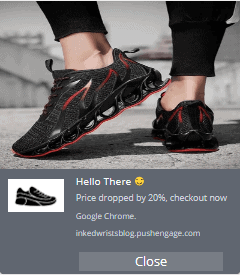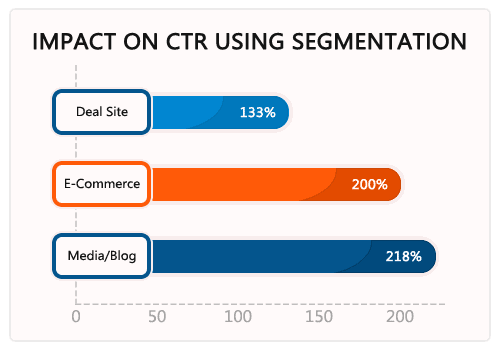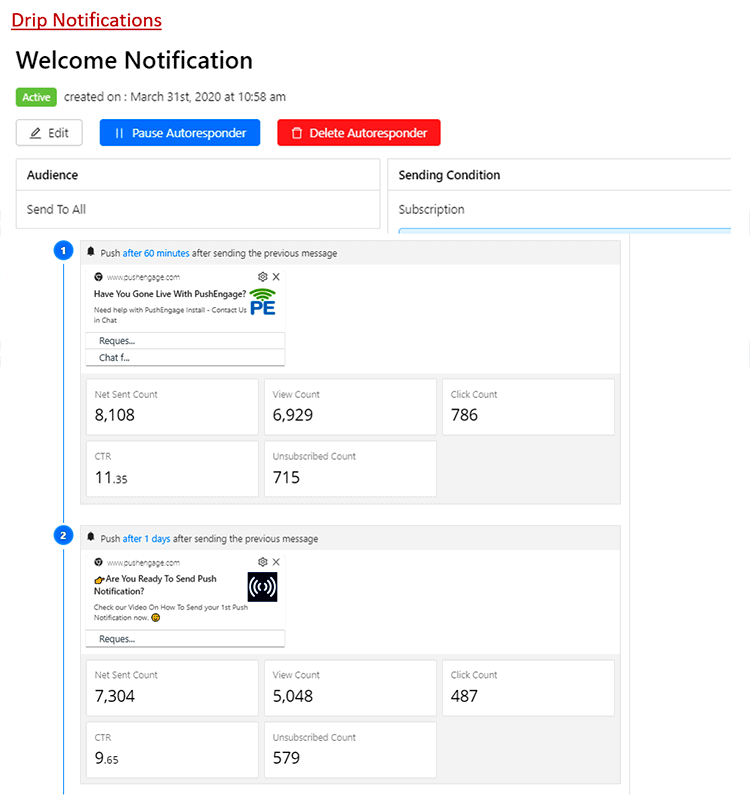This article was originally published on July 14, 2020, at Website Planet. Here is the link to the original article.
Browser push notifications are one of the newer channels available to boost customer engagement. Ravi Trivedi, Founder & CEO of PushEngage explains why these notifications are more effective than email marketing and how their platform effectively segments and automates push notifications so your users receive the content they want, increasing the conversion outcomes you want.
What is PushEngage?
PushEngage is a platform that helps you automatically segment and send web push notifications. We currently serve customers in over 150 countries and do between five to six billion push notifications a month.
What is a push notification?
Site owners are always looking for ways to get return visitors, and web push notifications are a recent channel of customer engagement that works like pop-ups in a browser window.
Unlike email marketing, users can subscribe to push notifications with a single click and do not need to enter their email address for you to send them contextual and personalized messages. It’s similar to a mobile app notification, except it works on your desktop and mobile browsers, which are more far-reaching.
What are some uses of push notifications?
Travel sites can set up PushEngage so users can request a price alert in the event; for example, the price of a flight from New York to London goes below $800.00. Now, if that ticket is available for less than $800.00 and they are online, they will be sent a pop-up notification that they can click to return to your site and hopefully complete the transaction.
Stock notification is another important use of push notification. In the event you are out of stock of a product rather than lose that customer, they can arrange to be notified by push when it becomes available again. The advantage of web push over email is that push notifications are in real-time, so you reach the user right away, and the metrics show that actionability is much higher.
If push notifications do not use an email address, what are they tied to?
Push notifications are tied to the browser and behave like a layer within the browser window. Browsers only give us a device token, which maps to that individual browser, and only they maintain their mapping. Therefore, no personal information is being exchanged when you receive consent to send a push notification.
Are push notifications more effective than email?
Yes. When sending an email, you’ll probably see a 10-20% open rate. Since push notifications contact users when they are online, the reach can be as high as 50-90%. Users are also more likely to click through because of this urgent messaging. So, let’s say I send 100 emails. I may see 3 to 5 people click through to my site, whereas if I send 100 push notifications, I will have 10 to 25 people come to my site.

Another key advantage is that unlike emails, push notifications can be set to expire. Let’s say you decide to run a flash sale today through midnight. If you send an email that a user does not see until the next day, it’s a bad experience for them. But you can set a web push to expire, so if a user goes online once the sale is over, they will never see that message
What is a trigger notification?
The critical thing to remember with push notifications is that users are not coming to you; you are going to them. Therefore, you should not push things that are important to you, but rather what is important to them.
A trigger alert is an alert based on user requests. An example would be if a user searches your used car site but does not find a car they want. They can request to receive an alert whenever additional cars are added to your inventory.
How can PushEngage be used for marketing?
As a site owner, the first thing you want to decide is when and how to gather consent. Should you ask when a user has landed? After they have read the article or completed a search? At PushEngage, we have done a lot of research and suggest waiting until a user has engaged a bit with your site before requesting consent.
Once you have gathered consent, segmentation is crucial. A basic rookie mistake is to send the same notification to everybody, which, while safe, does not work in most cases. That’s because different users have different preferences. One visitor to your site might be looking for a phone while another is interested in a fashion product.

Therefore, effective segmentation is based on what users do on your site. What products are they browsing? What content are they reading? Are they listening to podcasts or watching webinars?
How are these segments created?
Segments can be created in two ways. The first is by user preference. So, if a user is a Red Sox or a Manchester United fan, they can choose to receive notifications just about their preferred teams.
The second criterion is more of an inferred one. By using our built-in intelligence feature, Auto Segmentation, you can create segments based on rules you set. For example, you can determine that anyone who spends 80% of their time on your site reading about Manchester United or reads about Manchester United three times a week are definitely fans who should be part of the segment receiving MU notifications. Defining these rules can be done within our application without needing a web developer for coding.
If you want, you can segment even further into micro-segments by defining more than one user preference, kind of like a Venn diagram. So, for example, you can select users who like iPhones and are Beatles fans, or users who like iPhones and the Beatles, but not sports. With these segments, you can now create and send tailored notifications for more effective marketing.
What are automatic responders or drip campaigns?
A drip campaign is essentially an automatic, nurturing, timed series of push messages sent to users. Let’s take the earlier example of someone searching for a used car. You can now put them in a drip campaign, which on Day 1 will send them a push notification of your new inventory. On Day 2 you might send them information about insurance for used cars and on Day 3 perhaps send an article about what to look for when buying a used car.

A classic drip campaign would be the welcome drip, where you send a welcome coupon to new users once they register.
Some drips are triggered by user action. Perhaps the most popular trigger is cart abandonment, where a push notification is sent to remind users about items in their cart, so they come back and complete their purchase. Another trigger would be browser abandonment. You can decide, for example, that any time a user views the same product three times in ten days, to send them a nurturing notification about that product.
The entire concept is to automate these alerts, so they run on autopilot. The examples I gave so far are mainly for eCommerce sites, but they work for any type of website. A news site can push breaking news, astrology sites can push daily horoscopes, weather sites can push daily weather, and bloggers can send push notifications whenever they post new content. And of course, segmentation can be used as well. A tech blogger who writes about Android and iOS programming can have push notifications sent to their Android segment when they post about Android, and notifications pushed to their iOS segment when they write about iOS.
In terms of metrics, on eCommerce sites, we see anything between 5 – 20% extra traffic or revenue generated by these push notifications, and on content sites between 10 – 35/40% additional pageviews.

Can A/B testing be done in PushEngage?
A/B testing is a vital concept in marketing, so we made sure to include it in PushEngage as well. A/B testing is when you break your audience into two parts, A and B. By sending each group a different push notification, you can test which message or image works better and use the winner in subsequent campaigns. You can even do an A/B/C test where you take a sample of perhaps 30% and test half with A and half with B, and then send the winning notification to C – the remaining 70%.
What type of analytics and insights do you generate?
Our analytics start right at the beginning with daily reports on your opt-in rate and continues through every stage of your playbook.
We report on each push notification, including how many views and clicks it received, and the unsubscribe rate, as well as generate daily reports on the extra views and clicks your brand is getting.
A really big part of our reporting is, of course, revenue tracking. We show how many checkouts were driven by your web notifications, whether it was a stock alert, abandoned cart, browser abandonment, etc.
Since we have a lot of aggregate data, we produce Benchmark reports by industry type and region. So if you are an eCommerce site in the US, you can check the report to see the average Opt-in rate for notifications, click rate for segmentation, or the best time and day of the week to send notifications.

And we are always working on new AI features to drive better results. Intelligent Send, which will be released very soon, can track the usual time(s) a user consumes content on your site, and automatically send your push notifications at the best time to optimize views and clicks.